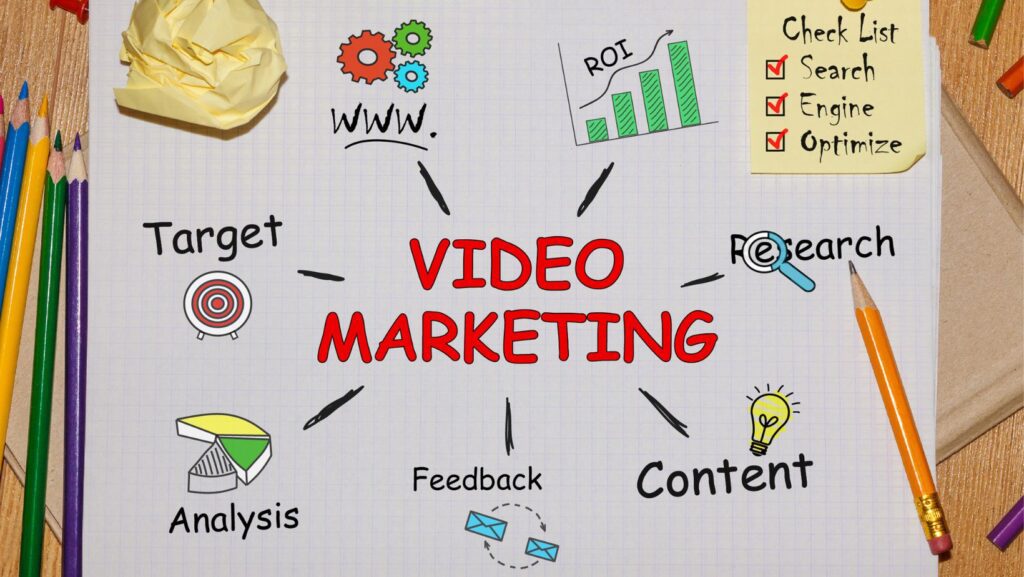Creating an Effective Video Marketing Strategy

Video has evolved as a significant tool for businesses to communicate with their audiences in the digital realm. It is no longer an option; it is a requirement for a strong marketing plan.
When done correctly, video marketing can captivate your audience, enhance your online visibility, and drive sales. But how do you develop a successful video marketing strategy?
Understanding Video Marketing
Video marketing is the strategic use of video to promote and market your product or service, increase engagement on your digital and social platforms, educate your consumers and customers, and reach out to a new audience.
The advantages of video marketing are numerous.
It can improve your SEO, click-through rates, open rates, conversion rates, and shareability. It’s an excellent technique to improve customer comprehension of your products or services.
Steps to Create an Effective Video Marketing Strategy

Define Your Goals and Objectives
- The first step in creating an effective video marketing strategy is to define your goals.
- What do you want to achieve with your videos?
- Are you looking to increase brand awareness, generate leads, or engage existing customers?
- Having clear objectives will guide your strategy and help measure your success.
Understand Your Target Audience
You need to understand who your target audience
What are their?
- Demographics
- Preferences
- Online Behavior
This information will help you create content that resonates with them and choose the right platforms to reach them.
Choose the Right Type of Video Content
The type of video content you create should align with your goals and appeal to your target audience. Here are a few types to consider:
- Explainer Videos: These are short online marketing videos used to explain your company’s product or service. They can be animated or live action, but they’re always straightforward and easy to understand.
- Product Demos: These videos show your product in action. They’re a great way to show off your product’s features and benefits.
- Testimonials: Customer testimonials are powerful tools for building trust and proving your product’s value. They show real people sharing their real experiences with your product.
- Behind-the-scenes: These videos give a glimpse into your company culture and the people behind your brand. They’re a great way to build a personal connection with your audience.
Plan Your Video Production Process

Once you’ve decided on the type of video content you want to create, you can start planning your production process.
This includes writing scripts, filming, and editing.
Each phase necessitates careful planning and execution to ensure that the final result is in line with your objectives and resonates with your target audience.
Optimize for SEO
Videos, like written content, must be optimized for search engines. Using relevant keywords in your video titles and descriptions, labeling your videos with relevant keywords, and offering transcriptions are all examples of this.
SEO optimization will assist your videos in being discovered in search results and reaching a larger audience.
Choose the Right Platforms for Distribution
It is critical to select the best platforms for your videos. Each platform has its own set of best practices, target audience, and requirements.
Shorter videos, for example, do better on social media, whereas lengthier, more thorough videos are better suited to YouTube or your website.
Measure and Analyze Performance
It is critical to track the performance of your videos. This includes tracking the number of views, engagement rate, and conversion rate.
These analytics will assist you in understanding what is and is not working, allowing you to alter your plan accordingly.
Tips for a Successful Video Marketing Strategy

Keep Videos Short and Engaging
In today’s fast-paced world, attention spans are short. Keep your videos concise and engaging to ensure your audience stays tuned in.
Use High-Quality Visuals and Audio
The quality of your video can make or break its success. High-quality visuals and clear audio are crucial for keeping your audience engaged and conveying your message effectively.
Include a Clear Call-to-Action
Every video should serve a purpose, and that purpose should be communicated to the audience clearly. Make sure your call-to-action is clear and engaging, whether it’s visiting your website, signing up for a newsletter, or purchasing a product.
Consistently Produce and Publish Videos
Consistency is crucial in video marketing. Producing and sharing films on a regular basis keeps your brand fresh in the minds of your audience and helps you build a loyal following.
Collaborate with Influencers or Industry Experts
Collaborations can help you broaden your reach and add a new viewpoint to your material. Consider collaborating with influencers or industry experts who can provide helpful insights while also promoting your videos to a larger audience.
Case Studies of Successful Video Marketing Strategies
Let’s take a look at a few case studies of firms that have successfully used video marketing to demonstrate its power.
Case Study 1: Dove’s “Real Beauty Sketches”
Dove’s “Real Beauty Sketches” campaign is an excellent example of a video marketing technique that is well received by the target population.
The movie, which depicts a forensic artist painting women as they describe themselves and then as others describe them, emphasizes the disparity between how we perceive ourselves and how others perceive us.
The video went viral, with over 67 million views on YouTube, sparking a global discussion on beauty standards.
Case Study 2: Blendtec’s “Will It Blend?”
With their “Will It Blend?” video marketing series, Blendtec, a company that offers professional and residential blenders, adopted a unique approach to video marketing.
To demonstrate the strength of its blenders, the company’s creator, Tom Dickson, attempts to blend various non-food items, ranging from iPhones to golf balls, in each video.
The videos are engaging, shareable, and successfully illustrate the benefits of the product.
Case Study 3: Airbnb’s “Wall and Chain”
The touching video “Wall and Chain” from Airbnb depicts the story of a woman who visits to Berlin and lives at an Airbnb in the same building where her father, a former Berlin Wall guard, previously patrolled.
The film, which beautifully depicts Airbnb’s purpose of making the globe a place where anybody can belong, has been viewed millions of times and widely shared on social media.
Action List: YouTube Video Marketing

This list acts as a road map, with clear and concrete actions to ensure that your video marketing activities are effective and produce the required outcomes.
Define Your Goals: Determine what you want to accomplish with your YouTube video marketing. This could include raising brand awareness, generating leads, or engaging with your target audience.
Understand Your Target Audience: Investigate and determine the demographics, tastes, and online behavior of your target audience. Use YouTube’s analytics tools to learn more about your audience.
Create a Content Plan: Choose the type of video material that will resonate with your audience and meet your objectives. This could include tutorials, product reviews, vlogs, interviews, and other similar content.
Script Your Videos: Create scripts for your videos to guarantee that they are well-structured and coherent. Make certain that your message is clear and appealing.
Produce High-Quality Videos: Invest in high-quality video equipment or engage a professional video production crew to assure the quality of your movies. It is critical to have good lighting, excellent audio, and stable camera work.
Optimize Your Videos for SEO: Use relevant keywords in your video titles, descriptions, and tags to increase the likelihood that your films will be found in search results. Additionally, give transcriptions for improved accessibility and SEO.
Create a Consistent Posting Schedule: Determine and stick to a regular posting schedule. Building and keeping an audience on YouTube requires consistency.
Engage with Your Audience: Respond to comments, solicit feedback, and encourage people to like, share, and subscribe to your videos. Engagement can assist increase the visibility of your content on YouTube.
Promote Your Videos: Share your videos on your other social media channels, website, and email newsletter. To attract a larger audience, you can also work with other YouTubers or influencers.
Analyze Your Performance: Track the performance of your videos with YouTube analytics tools. Examine indicators like view count, likes, shares, comments, watch time, and subscription growth to determine what is and is not working.
Iterate and Improve: Make any necessary changes to your video content, production, and promotion tactics based on your study. Improve your video marketing, by experimenting and learning.
It takes time and work to develop an effective video marketing strategy, but with perseverance and the appropriate technique, it can greatly enhance your online presence and engagement.
Final Thoughts

Developing an effective video marketing strategy may appear difficult, but with proper preparation and execution, it is possible to achieve considerable results.
You can use video to increase your brand’s online presence and promote business growth by defining clear goals, knowing your audience, creating compelling content, and monitoring your success.
It is not enough to create a single viral video for video marketing.
It’s about continuously delivering high-quality content that connects with your audience and coincides with the aims of your brand.
Begin developing your video marketing strategy and see what a difference it can make for your company.
FAQ
Q: What is video marketing?
A: Video marketing is a strategy that involves using videos to promote and market your product or service, increase engagement on your digital and social channels, educate your consumers and customers, and reach your audience with a new medium.
Q: Why is video marketing important?
A: Video marketing is beneficial since it can boost your search engine ranking, click-through rates, open rates, conversion rates, and shareability. It’s also an excellent technique to improve customer comprehension of your products or services.
Q: How do I start a video marketing strategy?
A: Starting a video marketing strategy entails defining your goals, identifying your target audience, selecting the appropriate type of video content, organizing your video production process, optimizing for SEO, selecting the appropriate distribution platforms, and evaluating and assessing performance.
Q: What types of video content can I create?
A: You may create a wide range of video content, including explainer videos, product presentations, testimonials, and behind-the-scenes footage. The information you select should be relevant to your goals and appealing to your target audience.
Q: How do I measure the success of my video marketing strategy?
A: Tracking important metrics like view count, engagement rate, and conversion rate can help you measure the performance of your video marketing plan. These analytics can assist you understand what is and isn’t working, allowing you to alter your strategy accordingly.
Q: What is SEO in video marketing?
A: Using relevant keywords in your video titles and descriptions, labeling your videos with relevant keywords, and providing transcriptions are all examples of SEO in video marketing. This increases the chances of your videos being found in search results and reaching a broader audience.
Q: How often should I post videos?
A: The frequency with which you post videos is determined by your resources and audience involvement. Consistency, on the other hand, is essential in video marketing. Producing and distributing videos on a regular basis keeps your brand fresh in the eyes of your audience and aids in the development of a devoted following.
Bio

Ronnie Patterson
Ronnie Patterson, founder of MagnÜron, is a multifaceted entrepreneur with a diverse background in music, electronics engineering, and engineering management. Drawing on experience across various industries, He offers expertise in SEO, operations, and strategy to help businesses thrive. Possessing a unique perspective and unwavering commitment to collaboration, and ideal partner for growth and success.






